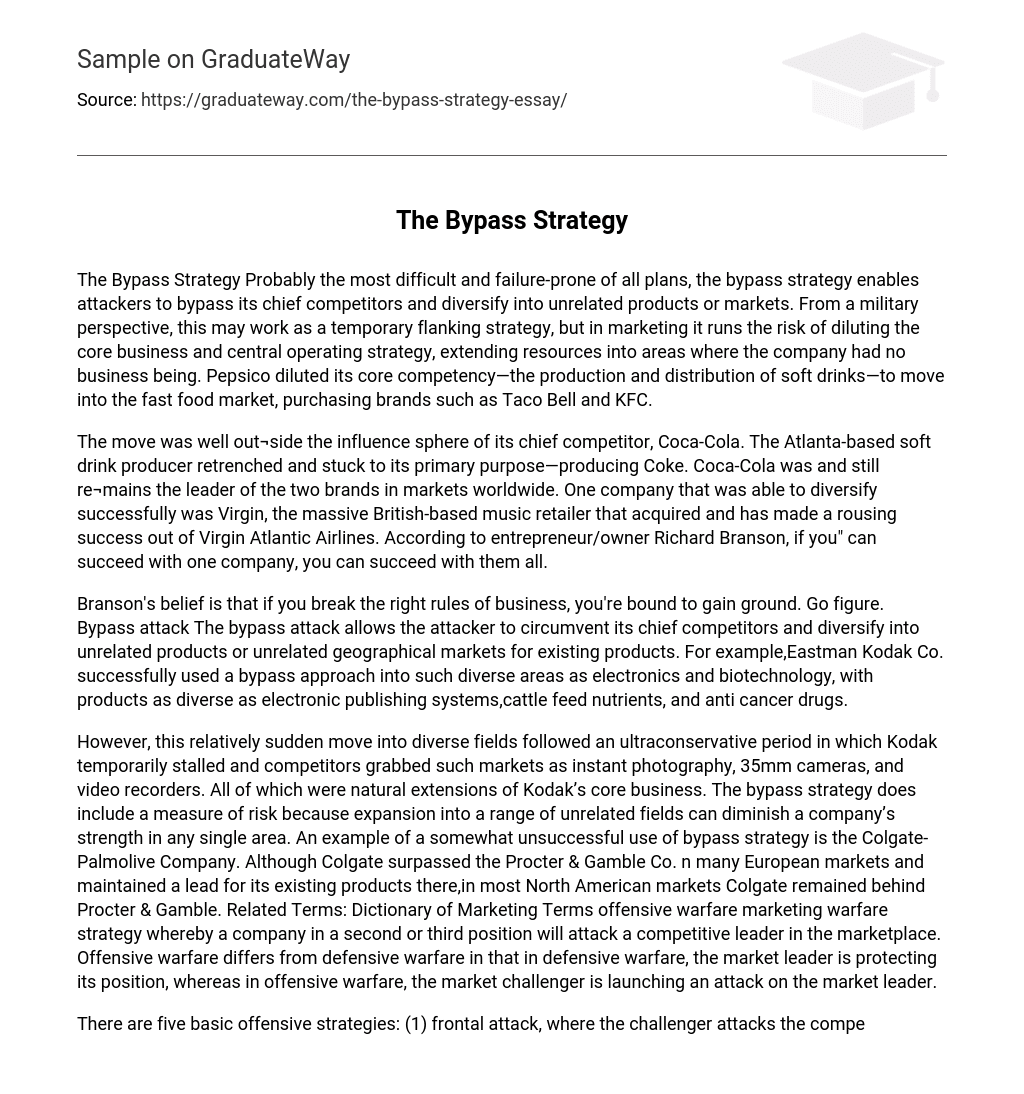The Bypass Strategy Probably the most difficult and failure-prone of all plans, the bypass strategy enables attackers to bypass its chief competitors and diversify into unrelated products or markets. From a military perspective, this may work as a temporary flanking strategy, but in marketing it runs the risk of diluting the core business and central operating strategy, extending resources into areas where the company had no business being. Pepsico diluted its core competency—the production and distribution of soft drinks—to move into the fast food market, purchasing brands such as Taco Bell and KFC.
The move was well out¬side the influence sphere of its chief competitor, Coca-Cola. The Atlanta-based soft drink producer retrenched and stuck to its primary purpose—producing Coke. Coca-Cola was and still re¬mains the leader of the two brands in markets worldwide. One company that was able to diversify successfully was Virgin, the massive British-based music retailer that acquired and has made a rousing success out of Virgin Atlantic Airlines. According to entrepreneur/owner Richard Branson, if you” can succeed with one company, you can succeed with them all.
Branson’s belief is that if you break the right rules of business, you’re bound to gain ground. Go figure. Bypass attack The bypass attack allows the attacker to circumvent its chief competitors and diversify into unrelated products or unrelated geographical markets for existing products. For example,Eastman Kodak Co. successfully used a bypass approach into such diverse areas as electronics and biotechnology, with products as diverse as electronic publishing systems,cattle feed nutrients, and anti cancer drugs.
However, this relatively sudden move into diverse fields followed an ultraconservative period in which Kodak temporarily stalled and competitors grabbed such markets as instant photography, 35mm cameras, and video recorders. All of which were natural extensions of Kodak’s core business. The bypass strategy does include a measure of risk because expansion into a range of unrelated fields can diminish a company’s strength in any single area. An example of a somewhat unsuccessful use of bypass strategy is the Colgate-Palmolive Company.
Although Colgate surpassed the Procter & Gamble Co. n many European markets and maintained a lead for its existing products there,in most North American markets Colgate remained behind Procter & Gamble. Related Terms: Dictionary of Marketing Terms offensive warfare marketing warfare strategy whereby a company in a second or third position will attack a competitive leader in the marketplace. Offensive warfare differs from defensive warfare in that in defensive warfare, the market leader is protecting its position, whereas in offensive warfare, the market challenger is launching an attack on the market leader.
There are five basic offensive strategies:
- frontal attack, where the challenger attacks the competitor’s strengths by matching the product, price, advertising, and distribution;
- flanking attack, where the challenger attacks the leader’s weakness by filling gaps not filled by the competitor and by developing strong products where the competitive products are the weakest;
- encirclement, where the challenger attacks from all directions;
- bypass attack, which is not really a direct attack but one where the challenger bypasses the competitor and targets an easier market, hoping that demand for its product will overtake the competitor’s product;
- guerrilla attack, where the challenger makes small periodic attacks with price cuts, executive raids, or concentrated promotional outbursts, hoping eventually to establish permanent footholds in the marketplace.
Dictionary of Marketing Terms defensive warfare competitive marketing strategies patterned after successful military defense strategies. Also called marketing warfare, defensive warfare is used by market leaders to protect their position in the marketplace against competitor attacks. There are six basic strategies:
- position defense, the most basic defense, which consists of building fortifications around the current market position;
- flanking defense, keeping careful check around the lanks and protecting the more vulnerable areas; preemptive defense, assumes that an ounce of prevention is worth a pound of cure and strikes out at competitors before they can make a move against the leading product;
- counter offensive defense, where the market leader studies the competitor’s offense to find a gap and make counterattacks at this weak point;
- mobile defense, wherein the market leader stretches to new markets that can serve as future bases for defense and offense;
- contraction defense, a strategic withdrawal from the marketplace, giving up weaker positions and concentrating resources on stronger ones, or serving fewer markets but serving them much better.





